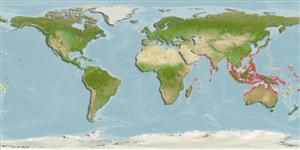Common names from other countries
Environment: milieu / climate zone / depth range / distribution range
Ecología
marino; agua dulce; salobre demersal; anfidromo (Ref. 51243); rango de profundidad 0 - 5 m (Ref. 90102). Tropical; 20°C - 28°C (Ref. 13371); 35°N - 33°S, 48°E - 171°W
Indo-Pacific: Kuwait to Fiji, north to southern Japan, south to New Caledonia. Reported from Samoa (Ref. 9710), Tonga (Ref. 53797), and the Society Islands (Ref. 2847).
Length at first maturity / Tamaño / Peso / Age
Maturity: Lm ?, range 14 - ? cm
Max length : 45.0 cm TL macho / no sexado; (Ref. 108711); common length : 20.0 cm TL macho / no sexado; (Ref. 3489)
Espinas dorsales (total): 10 - 11; Radios blandos dorsales (total): 16-18; Espinas anales 4; Radios blandos anales: 13 - 15. Ground colour greenish. Juveniles with a few large roundish blotches, about size of eye, or with about 5 or 6 broad, dark, vertical bars. In large adults, spots may be faint and restricted to dorsal part of flanks. Body quadrangular, strongly compressed. Dorsal head profile steep. Eye moderately large, its diameter somewhat smaller than snout length. Snout rounded. Mouth small, horizontal, not protractile. Teeth villiform, in several rows on jaws (ref 43044).
Inhabit harbors, natural embayments, brackish estuaries and the lower reaches of freshwater streams, frequently occurring among mangroves. Feed on worms, crustaceans, insects and plant matter (Ref. 7020, 44894, 48637). The dorsal, anal and pelvic spines are believed by Philippine fishers to be venomous and capable of inflicting wounds (Ref. 6565). Used in Chinese medicine (Ref. 12166). In Hong Kong live fish markets (Ref. 27253). Marketed as fresh (Ref. 12693).
Multiple spawner (Ref. 102820).
Allen, G.R., 1984. Scatophagidae. In W. Fischer and G. Bianchi (eds.) FAO species identification sheets for fishery purposes. Western Indian Ocean (Fishing Area 51). volume 4. [var. pag.]. FAO, Rome. (Ref. 3489)
IUCN Red List Status (Ref. 130435)
CITES (Ref. 128078)
Not Evaluated
Human uses
Pesquerías: escaso valor comercial; Acuicultura: comercial; Acuario: Comercial
Herramientas
Special reports
Download XML
Fuentes de Internet
Estimates based on models
Preferred temperature (Ref.
115969): 25.4 - 29.3, mean 28.6 (based on 2701 cells).
Phylogenetic diversity index (Ref.
82804): PD
50 = 0.8125 [Uniqueness, from 0.5 = low to 2.0 = high].
Bayesian length-weight: a=0.03236 (0.02371 - 0.04416), b=2.92 (2.83 - 3.01), in cm Total Length, based on LWR estimates for this species (Ref.
93245).
Nivel trófico (Ref.
69278): 3.0 ±0.35 se; based on food items.
Resiliencia (Ref.
120179): Alto, población duplicada en un tiempo mínimo inferior a 15 meses (tm=1; Fec=337,309; K=1.2).
Fishing Vulnerability (Ref.
59153): Low vulnerability (20 of 100).
